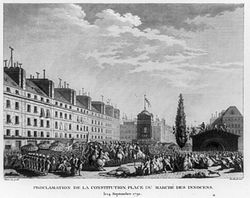History
The fountain was commissioned as part of the decoration of the city to commemorate the solemn royal entry of King Henry II into Paris in 1549. Artists were commissioned to construct elaborate monuments, mostly temporary, along his route, from the Port Saint-Denis to the Palais de la Cité, passing by le Châtelet, the Pont Notre-Dame and the Cathedral. The fountain was placed on the site of an earlier fountain dating to the reign of Philip II of France, against the wall of the Saints Innocents Cemetery, at the corner of rue Saint Denis (where the King's procession passed) and rue aux Fers (today's rue Berger), with two façades on one street, one façade on the other. It was to serve as a fountain as well as a grand reviewing stand for local notables; it resembled the walls of a large residence, with water taps along the street at the street level, and a stairway to the loggia on the upper level, where officials stood on the balcony to greet the King. Its original name was the Fountain of the Nymphs. [2]
Once the procession had passed, the structure became a simple water fountain for the neighborhood, with taps, ornamented with lion heads, permanently trickling water. [3] The upper floor of the fountain was eventually turned into a residence, with windows and a chimney. [4]
In 1787, for sanitary reasons, the cemeteries of Paris were moved outside the city walls, and the former cemetery of the Church of the Saints-Innocents, against whose wall the fountain stood, was transformed into a market square, le Marché des Innocents. The fountain was scheduled for destruction. It was saved largely by the efforts of writer Quatremère de Quincy, who wrote a letter to the Journal de Paris urging the preservation of "A masterpiece of French sculpture." [5] The fountain was moved to the middle of a large basin in the market, raised on a stone pedestal decorated with four lions and four basins. The sculptor Augustin Pajou was commissioned to create a fourth façade for the fountain, in the same style as the other three, so that it could be free-standing.
Because of the poor water supply system of Paris, the fountain produced only a small flow of water. Under Napoleon Bonaparte, a new aqueduct was constructed from the River Ourcq, and finally the fountain gushed water, in such abundance that it threatened the sculptural decoration. The smaller bas-reliefs at the base of the fountain were removed in 1810 and placed in the Musée du Louvre in 1824. [6]
In 1858, during the Second French Empire of Louis Napoleon, the fountain was again moved, to its present location on a modest pedestal in the middle of the square; and six basins of pouring water, one above the other, were added on each façade. [7]
Sculptural decoration
In 1547, Jean Goujon (1510–1572) became the court sculptor for Henry II, and this fountain was one of his first important commissions. In the same year he made illustrations for the French translation of the book of architecture by Vitruvius, a major classical source of the architecture of the Italian Renaissance and the French Renaissance. Later he worked again with Pierre Lescot on the bas-reliefs for the Cour Carrée of the Louvre Palace.
Though he was the court sculptor of Henry II, Goujon was a Protestant, and he fled to Italy during the French Wars of Religion, when Henry II began serious persecution of French Protestants.
Goujon was one of the first French sculptors to draw inspiration from the sculpture of ancient Rome, particularly the bas-relief sculptures on Roman sarcophagi. The nymph and triton on one of the fountain panels (see illustration) resembled a Roman sarcophagus in Grottaferrata, which was on display when Goujon was in Rome, and which had been the subject of several 16th century artists. The Triton’s hair resembled that in an ancient statue of The River Tiber, which had been discovered in Rome in 1512.
Goujon’s work on the fountain was also inspired by the Italian artists who had come to work for Francis I at the Château de Fontainebleau, Rosso Fiorentino (1495-1540) and Francesco Primaticcio (1504-1570). The nymph and sea dragon on the fountain had the same pose as the nymph of Fontainebleau, by Rosso, in the Galerie François I of the chateau, and the female forms of the nymphs, with their elongated bodies, narrow shoulders, and small, high breasts, resembled the idealized female figures of Primaticcio.
Goujon’s personal contribution was a decorative swirling movement in the sculptures, with undulating drapery and curling scrolls made of sea shells and the tails of sea creatures. [6]

The Place de la Concorde is one of the major public squares in Paris, France. Measuring 7.6 ha in area, it is the largest square in the French capital. It is located in the city's eighth arrondissement, at the eastern end of the Champs-Élysées.

A fountain, from the Latin "fons", meaning source or spring, is a decorative reservoir used for discharging water. It is also a structure that jets water into the air for a decorative or dramatic effect.

Pierre Lescot was a French architect active during the French Renaissance. His most notable works include the Fontaine des Innocents and the Lescot wing of the Louvre in Paris. He played an important role in the introduction of elements of classical architecture into French architecture.

Jean Goujon was a French Renaissance sculptor and architect.
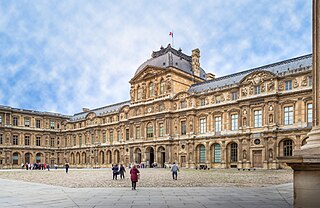
The Louvre Palace, often referred to simply as the Louvre, is an iconic French palace located on the Right Bank of the Seine in Paris, occupying a vast expanse of land between the Tuileries Gardens and the church of Saint-Germain l'Auxerrois. Originally a defensive castle, it has served numerous government-related functions in the past, including intermittently as a royal residence between the 14th and 18th centuries. It is now mostly used by the Louvre Museum, which first opened there in 1793.

French Renaissance architecture is a style which was prominent between the late 15th and early 17th centuries in the Kingdom of France. It succeeded French Gothic architecture. The style was originally imported from Italy after the Hundred Years' War by the French kings Charles VII, Louis XI, Charles VIII, Louis XII and François I. Several notable royal châteaux in this style were built in the Loire Valley, notably the Château de Montsoreau, the Château de Langeais, the Château d'Amboise, the Château de Blois, the Château de Gaillon and the Château de Chambord, as well as, closer to Paris, the Château de Fontainebleau.

The Lescot Wing is the oldest preserved structure above ground of the Louvre Palace in Paris, France. It was designed by architect Pierre Lescot and built between 1546 and 1551. Its architecture is influenced by Italian Mannerism. It had seminal influence on what became the Parisian Renaissance style, and beyond it, French architectural classicism.

The Medici Fountain is a monumental fountain in the Jardin du Luxembourg in the 6th arrondissement in Paris. Built in about 1630, it was commissioned by Marie de' Medici, the widow of King Henry IV of France and regent of King Louis XIII of France. It was moved to its present location and extensively rebuilt in 1864-1866.

The Fountains in Paris originally provided drinking water for city residents, and now are decorative features in the city's squares and parks. Paris has more than two hundred fountains, the oldest dating back to the 16th century. It also has more than one hundred Wallace drinking fountains. Most of the fountains are the property of the municipality.

The Fontaine des Quatre-Saisons is a monumental 18th-century public fountain, at 57-59 rue de Grenelle in the 7th arrondissement of Paris, France. It was executed by Edme Bouchardon, royal sculptor of King Louis XV, and opened in 1745. The fountain is huge and richly decorated, but it had only two water spouts, and its grand scale on the narrow street, together with the lack of water, irritated Voltaire and other figures of the French Enlightenment.

The Fontaine Louvois is a monumental public fountain in Square Louvois on the rue Richelieu in the Second Arrondissement of Paris, near the entrance of the Bibliothèque nationale de France. It was built between 1836 and 1839 during the reign of King Louis-Philippe.

Fountains in France provided drinking water to the inhabitants of the ancient Roman cities of France, and to French monasteries and villages during the Middle Ages. Later, they were symbols of royal power and grandeur in the gardens of the kings of France. Today, though they no longer provide drinking water, they decorate the squares and parks of French cities and towns.
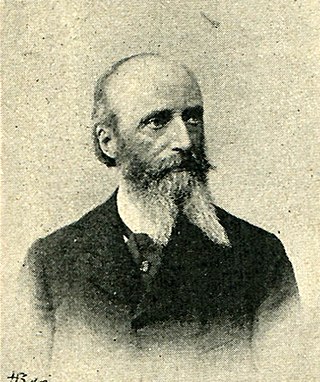
Charles-Auguste Lebourg was a French sculptor, best known for the sculptural design of the Wallace fountains, which are found in virtually every quarter of Paris and in various cities throughout the world. He also created numerous statues and busts in bronze and marble, winning recognition at various Salons and World's Fairs throughout the latter half of the nineteenth century. His work is on display at the Musée d'Orsay in Paris and the Fine Arts Museum in Nantes, as well as various parks and cemeteries in France.
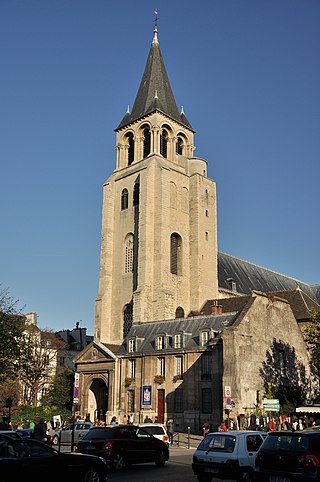
The city of Paris has notable examples of architecture of every period, from the Middle Ages to the 21st century. It was the birthplace of the Gothic style, and has important monuments of the French Renaissance, Classical revival, the Flamboyant style of the reign of Napoleon III, the Belle Époque, and the Art Nouveau style. The great Exposition Universelle (1889) and 1900 added Paris landmarks, including the Eiffel Tower and Grand Palais. In the 20th century, the Art Deco style of architecture first appeared in Paris, and Paris architects also influenced the postmodern architecture of the second half of the century.

During the 16th century, Paris was the largest city in Europe, with a population of about 350,000 in 1550.

The Fountain of Diana, also known as the Diana of Anet and Diana with a Stag, is a marble Mannerist sculpture of the goddess Diana, representing Diane de Poitiers. It was created c. 1550 to be the central ornament of a grand fountain in a courtyard of Diane de Poitier's Château d'Anet, but today is in the Louvre, Room 214 on the ground floor of the Richelieu Wing ; the Louvre has retitled it Diane appuyée sur un cerf. It was long believed to be the work of Jean Goujon, but the identity of the sculptor is now considered uncertain, although Benvenuto Cellini, Germain Pilon, Pierre Bontemps, and Ponce Jacquiot have in turn been suggested.

French sculpture has been an original and influential component of world art since the Middle Ages. The first known French sculptures date to the Upper Paleolithic age. French sculpture originally copied ancient Roman models, then found its own original form in the decoration of Gothic architecture. French sculptors produced important works of Baroque sculpture for the decoration of the Palace of Versailles. In the 19th century, the sculptors Auguste Rodin and Edgar Degas created a more personal and non-realistic style, which led the way to modernism in the 20th century, and the sculpture of Pablo Picasso, Georges Braque, Marcel Duchamp and Jean Arp.

The Nymph of Fontainebleau, also known as the Nymph of Anet or the Nymph with the Stag, is a c.‑1543 bronze relief, created by the Italian sculptor Benvenuto Cellini for the Château de Fontainebleau in France. It features a long-limbed reclining nude female nymph with a stag, wild boars, dogs, and other animals. It was Cellini's first large scale bronze casting.

The Pavillon du Roi was a tower-like structure built in the mid-16th century at the southern end of the Lescot Wing of the Louvre Palace. On its main floor was the primary apartment of the King of France. The pavilion served as a major emblem of the French monarchy for more than a century, and its design had seminal influence. From the 17th century, however, it gradually lost its visual and symbolic prominence. In the early 1640s, it was eclipsed by the slightly larger and more ornate Pavillon de l'Horloge; in the late 1660s, its main southern façade was hidden behind new structures; and in the early 19th century, its upper level was demolished and its interior arrangements were entirely remodeled.
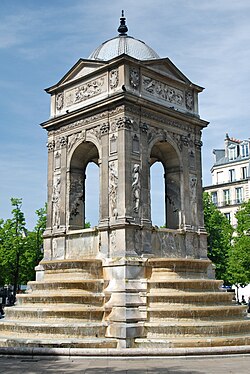
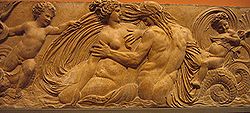


![Fontaine des Innocents [reliefs]; Louvre, Paris. Brooklyn Museum Archives, Goodyear Archival Collection Fontaine des Innocents reliefs. Louvre, Paris.jpg](http://upload.wikimedia.org/wikipedia/commons/thumb/6/6e/Fontaine_des_Innocents_reliefs._Louvre%2C_Paris.jpg/220px-Fontaine_des_Innocents_reliefs._Louvre%2C_Paris.jpg)
